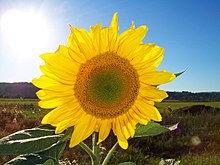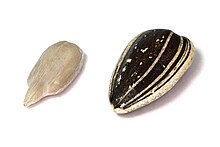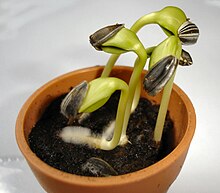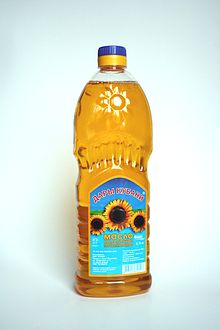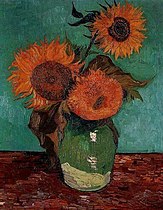Sunflower
| Sunflower | ||||||||||||
|---|---|---|---|---|---|---|---|---|---|---|---|---|

Sunflower ( Helianthus annuus ) |
||||||||||||
| Systematics | ||||||||||||
|
||||||||||||
| Scientific name | ||||||||||||
| Helianthus annuus | ||||||||||||
| L. |
The sunflower ( Helianthus annuus ), also Common Sunflower called, is a plant of the genus of the sunflower ( Helianthus ) in the family of the daisy family (Asteraceae).
Description and ecology

1 bracts,
2 ray flowers,
3 tubular flowers,
4 basket bottom.
Vegetative characteristics
The sunflower is an herbaceous plant that usually reaches heights of 1 to 2, less often 3 meters. It does not form tubers. The stem is coarsely hairy.
Almost all change-constant on the stem arranged leaves are divided into petiole and leaf blade. The simple leaf blade is up to 40 centimeters long and 35 centimeters wide and is heart-shaped with a sawn edge.
Generative characteristics
The nodding flower heads are 10 to 40 centimeters in diameter. The mostly yellow ray florets are 6 to 10 centimeters long and the tubular florets are brown.
The number of chromosomes is 2n = 34.
ecology
The sunflower is an annual, cultivated plant with roots up to 2 meters deep. It is very photosynthetic ; a large plant binds the carbon dioxide present in a room of 100 cubic meters per day . However, the plants are very light dependent d. In other words, the net photosynthesis rate is directly related to the logarithm of the light intensity, which is why plants that are even slightly poorer in the sun remain much smaller. It is a typical plant in warm locations, i. That is, it is a warmth germ , it has its maximum growth at 20 degrees Celsius and its cotyledons fold together at night.
In terms of flower ecology, the false flowers ( Pseudanthium ) are large "cup-shaped flowers", which often consist of over 15,000 individual flowers. The flowers are pre-male. The tongue-shaped marginal flowers are sterile and have a high UV reflection. The disk flowers are hermaphroditic. The pollination is carried by various insects . At the time of main production between 10 a.m. and 2 p.m., the nectar also has the highest sugar content of 35%. The flower heads are almost always set up for "noon"; so the sunflowers are compass plants . The peculiarity of the plant to always turn towards the sunlight is called heliotropism . On sunny days, the bud tracks the sun from east to west, while turning back to east at night or at dawn. Even if this is assumed for the ripening plant, only the leaves and buds turn towards the sun, but not the fruit heads . These usually point to the east. At the end of the bud stage, the trunk hardens its eastern orientation and, when the overexposure stage is reached, the trunk "freezes" it to a certain extent. Sunflowers in bloom are no longer heliotrope, and most of the heads point in the direction of sunrise.
The flowering period extends from late June / July to September.
The fruits are achenes without pappus , but there are many hard chaff leaves on the basket floor as bracts for the individual flowers; These are used for the catapult-like spreading of the fruits, especially when they are processed by birds . In addition, there is a hiding spread z. B. by mice . In addition, the fruits spread as rainworms. The achenes are light and warmth germs.
The leaves are attacked by sunflower rust.
Occurrence
The sunflower is believed to be native to southern Canada ( Alberta , British Columbia , Manitoba , Saskatchewan ), all US states and the Mexican states of Baja California , Chihuahua , Coahuila , Durango , Nuevo León , Sonora and Tamaulipas . It is a neophyte in the rest of the states or provinces of Canada, New Brunswick , Nova Scotia , Ontario , Prince Edward Island , Québec and Northwest Territories .
origin
The wild sunflower was originally widespread from North to Central America . Archaeological results show that the sunflower was found around 2500 BC. In the Mississippi region and also in Mexico City . Francisco Pizarro observed the Incas who worshiped the sunflower as the image of their god.
Sunflower seeds were brought from America to Europe by Spanish sailors in 1552 , where they were initially grown as an ornamental plant. One of the first herbal books to report on the plant as “Great Indian Sunflower” or “Flos Solis Peruvianus” is the Kreutterbuch by Pietro Andrea Mattioli from 1590, which Joachim Camerarius the Younger edited and translated. There he writes on page 262: "In 1584 we all had flowers". From that year the sunflower was known in German and European gardens. This confirms the statement made by Camerarius in the Hortus Medicus from 1588, page 61 about "Chrysanthemum Peruvianum": Nostris hortis iam familiaris planta (German: "Is already known in our gardens").
Origin of the name
The botanical genus name Helianthus is derived from the Greek words helios for "sun" and anthos for "flower". The name comes from Greek mythology and is passed down in a poem by Ovid : The girl Clytia once fell in love with the god Apollo . The latter spurned Clytia and thereupon she sat down naked on a rock, ate and drank nothing and lamented her misfortune. The lover watched Apollo for nine days as he moved his chariot across the sky. Then her heartache turned to yellow and brown colors: She turned into a "sunflower", which always turned its flower towards the sun (Apollo's sun chariot). Since the plant known as the sunflower comes from America, the plant must have been something different from Greek mythology; probably a representative of the genus solstices ( heliotropium ).
The specific epithet annuus is derived from the term for "annual" and refers to the annual vegetation phase.
Cultivation
A prerequisite for successful cultivation for commercial purposes is a deep, humus and nutrient-rich soil (especially potassium and boron , nitrogen fertilization approx. 100 kg N / ha) with sufficient water supply (water requirement 400 to 500 ml) and a heat sum during the sunflower vegetation season in April by September of at least 14 ° C (based on a reference temperature of 6 ° C, but at least 5 ° C). Sowing takes place at a soil temperature of 7 to 8 ° C in early April with a row spacing of 75 cm and a spacing in the row of 45 cm. For the purpose of connection to the capillary water of the soil and to ensure a safe emergence, a sowing depth of 4 to 6 cm should be aimed for. With a seed density of 6 to 7 plants / square meter, 60,000 to 70,000 sunflowers will grow per hectare . Weed control is indicated up to the end of the row , after which it is unnecessary due to the high level of competition. The crop is ready for harvest as soon as the grain moisture is between 12 and 18%. Externally visible signs of harvestability are dead leaves and yellow-colored undersides of the basket. The harvest takes place with combine harvesters that have been converted to meet the special requirements of sunflower harvesting .
In 2018, sunflowers were grown on 26.7 million hectares worldwide. The sunflower is therefore the oil plant that occupies the third largest cultivation area in the world, after soybeans (124.9 million hectares) and rapeseed (37.6 million hectares) and ahead of oil palms and olive trees .
In Switzerland, sunflowers were grown on an area of 5,386 hectares in 2018, which corresponds to a growth of 2.4% compared to the previous year.
Economical meaning
According to the FAO, 51,954,779 tons of sunflower seeds were harvested worldwide in 2018. The ten largest producers brought in 84.7% of the world harvest. The values for Austria, Germany and Switzerland are shown for comparison.
| rank | country | Quantity (in t ) |
|---|---|---|
| 1 |
|
14,165,170 |
| 2 |
|
12,755,725 |
| 3 |
|
3,537,545 |
| 4th |
|
3,062,690 |
| 5 |
|
2,550,000 |
| 6th |
|
1,949,229 |
| 7th |
|
1,927,040 |
| 8th |
|
1,832,212 |
| 9 |
|
1,247,936 |
| 10 |
|
959.990 |
| ... | ||
| 28 |
|
60,304 |
| 37 |
|
31,000 |
| 46 |
|
13,079 |
use
Sunflower seeds
From the 17th century, the kernels were used for baked goods or roasted as a substitute for coffee and drinking chocolate. In Russia and the Balkans, roasted sunflower seeds are eaten as so-called "semetschki". A similar product, the “ pipas de girasol ”, is very popular in Spain and in Turkey the product is known as “Çekirdek”. The roasted sunflower seeds can be bought packaged in bags and are bitten and eaten on the way, the shells are spat out.
Sunflower seeds are also used for germination and develop their ingredients all the more. In addition, its use as bird food plays a major role. The main growing countries in 2017 were Ukraine, Russia and Argentina.
Often sunflower seeds are processed in roasted, peeled form in baked goods and confectionery and are part of many muesli mixes.
Average composition
The composition of sunflower seeds naturally fluctuates, both depending on the environmental conditions (soil, climate) and the cultivation technique (fertilization, plant protection).
Details per 100 g of ripe, dried sunflower seeds:
|
|
|
|
1 mg = 1000 µg
The physiological calorific value is 2405 kJ , corresponding to 580 kcal per 100 g of edible portion.
Sunflower seed flour
A flour that is usually defatted and high in protein, obtained from sunflower seeds, is used for fortification purposes in the food industry, primarily in the production of baked goods. It has a nutty taste.
Sunflower oil
The sunflower has only been used as an oil plant since the 19th century . The sunflower oil is valuable for human nutrition , should be but because of the high content of multiple unsaturated fatty acids rather than frying oil can be used (with the exception of high-oleic variants). In the case of sunflowers used for agriculture, the oil content of the fruit is between 48 and 52%. Sunflower oil, pressed from the seeds, is used in cooking. In contrast to refined oil, unrefined oil, which is more common in Eastern European countries, has a strong taste and is therefore particularly suitable as a flavor carrier for the preparation of warm dishes and salads. Refined oil can be used in lubricating oils , fuels, and plasticizers . The press residue or the defatted flour can be used as fodder .
In addition to being used as an edible oil, sunflower oil is also used in pharmacy and medicine, as well as for industrial uses. In pharmacy, the oil is a filling material in soft gelatine capsules , it is also used for ointments and creams and can replace olive oil or peanut oil in medical products. Sunflower oil is traditionally used for constipation and externally for treating wounds and rheumatism .
Sunflower oil is used industrially for paints and varnishes, and it is also found in oil and artist paints. It is also used in leather processing and in cloth manufacture (preservative). As a biofuel , pure sunflower oil can be used as vegetable oil fuel, but unlike rapeseed oil fuel, the fuel qualities have only been little researched and there is no reduction in the mineral oil tax. In contrast, it is common to produce biodiesel from sunflower oil: Around 10% of the biodiesel produced in Europe in 2007 consists of sunflower oil methyl ester (SME), which is produced from sunflower oil and methanol by transesterification .
Sunflower straw
Sunflower straw is the term used for the stems that remain as crop residues after the harvest. In the case of sunflowers, the grain-to-straw ratio is around 1: 4.1, so that with an average grain yield of around 2.5 t per hectare and year, theoretically 10 t of crop residues remain in the field in the form of straw. It can be assumed that the recovery rate will be significantly lower than with other straw goods, but no corresponding experience is available.
As a rule, sunflower straw is not used due to the very high water content of the thick stalks and the very high ash content of 10% and other properties that are disadvantageous for combustion. It has a calorific value of 16.9 MJ / kg.
In the Hungarian lowlands , flutes and other flutes are made from the stems .
Sunflower sprouts
In many countries i. B. in Asia, sunflower sprouts are eaten like vegetables.
Reported effect
In Russian and Ukrainian folk medicine , sunflower oil is used for oil cures . In the practice, also known as oil pulling, the organism is to be detoxified and purged . However, there is no evidence of an effect.
sorts
The sunflower varieties can be divided into four types:
- The oil type has a particularly large number of tubular flowers. The sunflower seeds have a very small amount of shell. The kernels of around 60 sunflowers are required for one liter of oil.
- The type of forage develops a particularly large amount of leaf substance. It is used as a green fodder and for producing silage as well as in stubble cultivation for green manuring.
- The ornamental type grows in gardens and often has several inflorescences per plant.
- The food type is characterized by large and loosely seated kernels. Also worth mentioning are new transgenic strains that are immune to some diseases.
Dwarf varieties reach heights of growth up to 70 cm. They are more stable than the meter-high sunflower varieties and are ideal for window boxes. The varieties include:
- 'Sunspot', which flowers golden yellow and is 40 to 60 cm high and
- 'Double Dandy', which has semi-double, pollen-free red flowers and grows to around two feet tall.
Tall growing varieties are:
- 'Ring of Fire', up to 120 cm high, red-yellow flamed petals;
- 'Sunrich Orange', up to 170 cm high, orange flowers;
- 'Titan', up to 3.50 m high, bright yellow flowers;
- 'King Kong', up to 4 m high with large flowers.
Sunflowers in the fine arts

The sunflower is a common style element in the fine arts . The flower shape of the sunflower is particularly evident in still lifes with floral depictions. Vincent van Gogh's pictures of the sunflower in a vase are particularly well known . There is a series of paintings by him of the sunflower: three sunflowers in a vase, five sunflowers ..., twelve sunflowers in a vase , fifteen sunflowers ....
- Paintings of the sunflower in a vase by Vincent van Gogh
Symbolic
- As " Helianth ", the sunflower is the title of Albrecht Schaeffer's most important novel .
- It is also a state symbol of the US state of Kansas and one of the city flowers of Kitakyushu , Japan.
- It is also the identification symbol of the political party Die Grünen ( Bündnis '90 / Die Grünen) as well as other international and ecologically oriented parties from the New Social Movements .
- In addition, sunflowers are a symbol of the hippie movement (flower children).
- From 1982-2002 50 NLG banknotes were in circulation with the Zonnebloem .
- The sunflower railing is a landmark of Vienna that can be found throughout the city.
literature
- S. Krist, G. Buchbauer, C. Klausberger: Lexicon of vegetable fats and oils. Springer Verlag, Vienna 2008, ISBN 978-3-211-75606-5 , pp. 434–441.
- Atlant Bieri: twice cherished, always looked after. Neue Zürcher Zeitung NZZ am Sonntag, Zurich, May 25, 2008, p. 84.
- Walter Schuster: The breeding of the sunflower. 1993, ISBN 3-489-53310-0 .
- Henning Haeupler , Thomas Muer: picture atlas of the fern and flowering plants of Germany (= the fern and flowering plants of Germany. Volume 2). 2nd, corrected and enlarged edition. Published by the Federal Agency for Nature Conservation. Ulmer, Stuttgart 2007, ISBN 978-3-8001-4990-2 .
- Ruprecht Düll , Herfried Kutzelnigg : Pocket dictionary of plants in Germany and neighboring countries. The most common Central European species in portrait. 7th, corrected and enlarged edition. Quelle & Meyer, Wiebelsheim 2011, ISBN 978-3-494-01424-1 .
Web links
- Sunflower . In: BiolFlor, the database of biological-ecological characteristics of the flora of Germany.
- Helianthus annuus L., common sunflower. In: FloraWeb.de.
- Walter H. Schuster, Richard A. Marquard: The Sunflower (Helianthus annuus L.) With 18 tables and 73 illustrations. Institute for Plant Cultivation and Plant Breeding, Justus Liebig University Gießen, 2003.
- Country of origin Arkansas USA.
Individual evidence
- ^ Edward E. Schilling: Helianthus Linnaeus. Helianthus annuus - the same text online as the printed work , In: Flora of North America Editorial Committee (Ed.): Flora of North America North of Mexico , Volume 21 - Magnoliophyta: Asteridae (in part): Asteraceae, part 3 , Oxford University Press, New York and Oxford, 2006, ISBN 0-19-530565-5 .
- ^ Erich Oberdorfer : Plant-sociological excursion flora for Germany and neighboring areas . With the collaboration of Angelika Schwabe and Theo Müller. 8th, heavily revised and expanded edition. Eugen Ulmer, Stuttgart (Hohenheim) 2001, ISBN 3-8001-3131-5 , pp. 927 .
- ↑ Sunflowers on gartendialog.de.
- ↑ Sunflowers in the [www.natur-lexikon.de Naturlexikon]
- ↑ Sunflowers at www.naturdetektiven.de . ( Memento of the original from July 18, 2017 in the Internet Archive ) Info: The archive link was inserted automatically and has not yet been checked. Please check the original and archive link according to the instructions and then remove this notice.
- ↑ George Baker Cummins : Rust Fungi on Legumes and Composites in North America . University of Arizona Press, Tucson 1978, ISBN 0-8165-0653-1 .
- ^ A b Helianthus in the Germplasm Resources Information Network (GRIN), USDA , ARS , National Genetic Resources Program. National Germplasm Resources Laboratory, Beltsville, Maryland. Retrieved March 4, 2018.
- ↑ Atlant Bieri: twice cherished, always cared for. In: NZZ am Sonntag , Zurich, May 25, 2008, p. 84.
- ↑ Klaus-Ulrich Heyland (editor), Special Plant Cultivation, 7th edition, Ulmer, Stuttgart, 1952, 1996, ISBN 3-8001-1080-6 , pp. 114 ff., 309.
- ↑ a b c Crops> Sunflower seed. In: FAO production statistics for 2018. fao.org, accessed on March 20, 2020 .
- ↑ Alice Sager: Ten Facts About the New Numbers About Agriculture. In: bauernzeitung.ch. May 28, 2019. Retrieved May 28, 2019 .
- ↑ German Research Institute for Food Chemistry, Garching (ed.): Food table for practice . The little souci · specialist · herb. 4th edition. Wissenschaftliche Verlagsgesellschaft, Stuttgart 2009, ISBN 978-3-8047-2541-6 , p. 333 .
- ↑ YouTube. Retrieved July 7, 2020 .
- ↑ Waldemar Ternes , Alfred Täufel, Lieselotte Tunger, Martin Zobel (eds.): Food Lexicon . 4th, comprehensively revised edition. Behr, Hamburg 2005, ISBN 3-89947-165-2 .
- ↑ a b S. Krist, G. Buchbauer and C. Klausberger: Lexicon of vegetable fats and oils. Springer Verlag, Vienna 2008, pp. 434–441, ISBN 978-3-211-75606-5 .
- ↑ www.biokraftstoff-portal.de: Global biodiesel production uses around eight million tons of vegetable oil. ( Page no longer available , search in web archives ) Info: The link was automatically marked as defective. Please check the link according to the instructions and then remove this notice. Message dated March 17, 2008, accessed October 27, 2009.
- ↑ Stalk-like biomass: corn stalks. In: Martin Kaltschmitt , Hans Hartmann, Hermann Hofbauer (Hrsg.): Energy from biomass. Basics, techniques and procedures. Springer Verlag, Berlin and Heidelberg 2009; P. 153. ISBN 978-3-540-85094-6 .
- ↑ Martin Kaltschmitt, Hans Hartmann and Hermann Hofbauer (eds.): Energy from biomass. Basics, techniques and procedures. Springer Verlag, Berlin 2009, ISBN 978-3-540-85094-6 , 2nd edition, p. 360.
- ^ Bálint Sárosi: The folk musical instruments of Hungary. Deutscher Verlag für Musik, Leipzig 1967, p. 69.
- ^ Netherlands (banknotes) , accessed August 1, 2019

